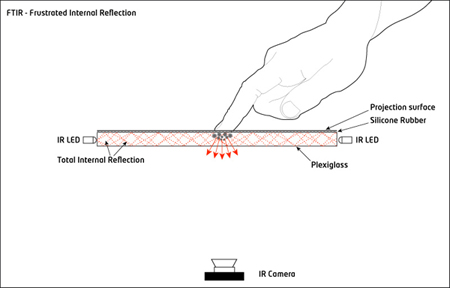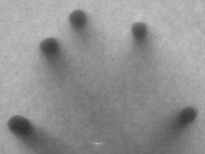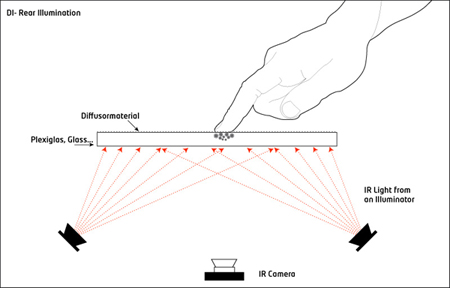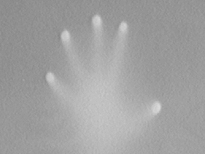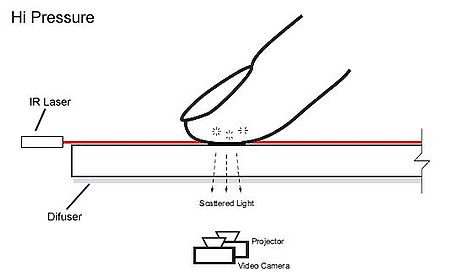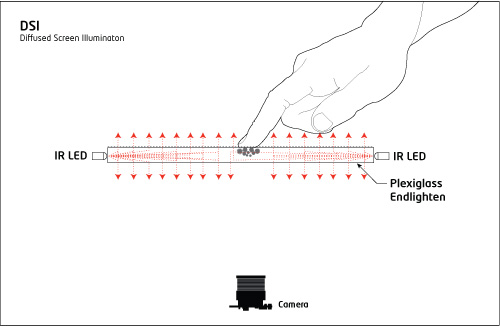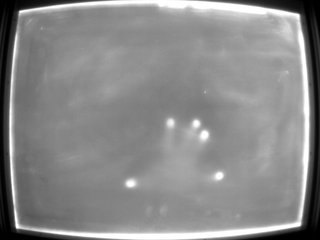Multitouch
|
Creator: |
Contents
Overview
This is a research page for all things multitouch.
Methods
Frustrated Total Internal Reflection (FTIR)
It is a name used by the multi-touch community to describe the multi-touch methodology developed by Jeff Han (Han 2005). The phrase actually refers to the well-known underlying physical phenomena underlying Han’s method. Total Internal Reflection describes a condition present in certain materials when light enters one material from another material with a higher refractive index, at an angle of incidence greater than a specific angle (Gettys, Keller and Skove 1989, p.799). The specific angle at which this occurs depends on the refractive indexes of both materials, and is known as the critical angle, which can be calculated mathematically using Snell’s Law.
When this happens, no refraction occurs in the material, and the light beam is totally reflected. Han’s method uses this to great effect, flooding the inside of a piece of acrylic with infrared light by trapping the light rays within the acrylic using the principle of Total Internal Reflection. When the user comes into contact with the surface, the light rays are said to be frustrated, since they can now pass through into the contact material (usually skin), and the reflection is no longer total at that point.
FTIR Parts List:
- Acrylic/Polycarbonate/Plexiglass
- Infrared LEDs (or similar infrared light source)
- Compliant Surface (silicone rubber ie. Sorta Clear 40, Elastosil, Lexel, etc. )
- Projection Surface (Rosco Grey, Vellum, Mylar, other, etc.)
- Infrared Camera/Modified Webcam
Pros:
- An enclosed box is not required
- Blobs have strong contrast
- Allows for varying blob pressure
- With a compliant surface, it can be used with something as small as a pen tip
Cons:
- Setup calls for some type of LED frame (soldering required)
- Requires a compliant surface (silicone rubber) for proper use
- Cannot recognize objects or fiducial markers
- Cannot use a glass surface
Front Diffused Illumination (MTMini)
Infrared light (often from the ambient surroundings) is shined at the screen from above the touch surface. A diffuser is placed on top or on bottom of the touch surface. When an object touches the surface, a shadow is created in the position of the object. The camera senses this shadow.
Front DI Parts List
- Clear sturdy surface (Glass, Acrylic, Polycarbonate, Plexiglas, etc.)
- Diffuser/Projection Surface (Vellum, Mylar, Lee Filter, other, etc.) *Note: The Diffuser/Projection Surface must let some light through.
- Infrared Camera/Modified Webcam
Pros:
- No need for a compliant surface, just an diffuser/projection surface on top/bottom
- Can use any transparent material like glass (not just acrylic)
- No LED frame required
- No soldering (you can buy the IR-Illuminators ready to go)
- Can track fingers and hovering
- An enclosed box is not required
- Simplest setup
Cons:
- Cannot track objects and fiducials
- Difficult to get even illumination
- Greater chance of ‘false blobs’
- Not as reliable (relies heavily on ambient lighting environment)
Rear Diffused Illumination (DI)
Infrared light is shined at the screen from below the touch surface. A diffuser is placed on top or on bottom of the touch surface. When an object touches the surface it reflects more light than the diffuser or objects in the background; the extra light is sensed by a camera. Depending on the diffuser, this method can also detect hover and objects placed on the surface.
Rear DI Parts List:
- Clear sturdy surface (Glass, Acrylic, Polycarbonate, Plexiglas, etc.)
- Infrared Illuminator (Infrared LEDs, Infrared Illuminator, etc.)
- Diffuser/Projection Surface (Vellum, Mylar, Lee Filter, other, etc.) *Note: The Diffuser/Projection Surface must let some light through.
- Infrared Camera/Modified Webcam
Pros:
- No need for a compliant surface, just an diffuser/projection surface on top/bottom
- Can use any transparent material like glass (not just acrylic)
- No LED frame required
- No soldering (you can buy the IR-Illuminators ready to go)
- Simple setup
- Can track objects, fingers, fiducials, hovering
Cons:
- Difficult to get even illumination
- Blobs have lower contrast (harder to pick up by software)
- Greater chance of ‘false blobs’
- Enclosed box is required
Laser Light Projection (LLP)
Infrared light from a laser(s) is shined just above the surface. The laser plane of light is about 1mm thick and is positioned right above the surface, when the finger just touches it, it will hit the tip of the finger which will register as a IR blob.
LLP Parts List:
- Clear, flat surface (Glass, Acrylic, Polycarbonate, Plexiglass, etc.)
- Infrared Laser(s)
- Safety Goggles
- Line Generating Lens
- Projection Surface
- Infrared Camera/Modified Webcam
Pros:
- No compliant surface (silicone)
- Can use any transparent material like glass (not just acrylic)
- No LED frame required
- An enclosed box is not required
- Simplest setup
- Could be slightly cheaper than other techniques
Cons:
- Cannot track traditional objects and fiducials
- Not truly pressure sensitive (since light intensity doesn’t change with pressure).
- Can cause occlusion if only using 1 or 2 lasers where light hitting one finger blocks another finger from receiving light.
Diffused Side Illumination (DSI)
DSI uses a special acrylic to distribute the IR evenly across the surface. Basically use your standard FTIR setup with an LED Frame (no compliant silicone surface needed), and just switch to a special acrylic. This acrylic uses small particles that are inside the material, acting like thousands of small mirrors. When you shine IR light into the edges of this material, the light gets redirected and spread to the surface of the acrylic. The effect is similar to DI, but with even illumination, no hotspots, and same setup process as FTIR.
DSI Parts List:
- EndLighten Acrylic
- LEDs
- Projection Surface (tracing paper, lee filter, geriets optitrans , etc);
- Infrared Camera/Modified Webcam
Pros:
- No compliant surface (silicone)
- Can easily switch back and forth between DI (DSI) and FTIR
- Can detect objects, hovering, and fiducials
- Is pressure sensitive
- No hotspots
- even finger/object illumination throughout the surface
Cons:
- Endlighten Acrylic costs more than regular acrylic (but the some of the cost can be made up since no IR illuminators are needed)
- Blobs have lower contrast (harder to pick up by software) than FTIR and LLP
Software
Hardware
- Sony PS3Eye
- IR LED strips
- IR lasers
